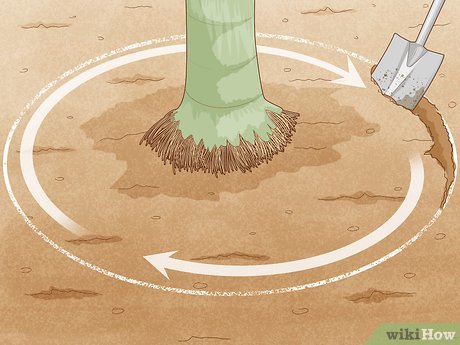Gently swaying in the tropical breeze, palm trees have long been symbolic of exotic lands and paradisiacal escapes. Their gracefully elongated trunks and vivid green fronds create an awe-inspiring sight that instantly transports us to sun-drenched coastlines. However, there may come a time when the need arises to bid farewell to these majestic botanical wonders. Whether it’s for landscaping purposes or simply the fact that your palm tree has outgrown its welcome, the art of removing a palm tree requires finesse and careful consideration. In this guide, we explore the secrets behind parting ways with these arboreal treasures, ensuring a harmonious transition as we bid adieu to our tropical companions. Let’s gracefully unravel the steps to safely and efficiently remove a palm tree while paying homage to its enduring allure.
Preparing the Ground: Necessary steps before removing a palm tree
1. Assess the Tree
Before you embark on the task of removing a palm tree, it is crucial to assess its condition. Look for any signs of disease or decay, as these can affect the ease and safety of removal. Additionally, evaluate the size of the tree and its location. Consider whether it may pose any risks to nearby structures or utilities. This assessment will help you plan for the removal process.
<h3>2. Gather the Proper Tools</h3>
<p>Removing a palm tree requires using the right tools to ensure efficiency and safety. Here are some essential tools you should gather:</p>
<ul>
<li><strong>Chainsaw:</strong> A chainsaw with a sharp blade is crucial for cutting the trunk and limbs of the palm tree.</li>
<li><strong>Ladders:</strong> Depending on the height of the tree, you may need a ladder or an aerial lift to access upper sections safely.</li>
<li><strong>Protective Gear:</strong> Wear gloves, safety goggles, and a hard hat to protect yourself from falling debris and potential injuries.</li>
<li><strong>Rope and Pulley System:</strong> If the tree is close to structures or utilities, a rope and pulley system can help control the direction of the fall.</li>
</ul>| Features | Tips |
|---|---|
| 1. Assess the Tree | Before removing the palm tree, inspect it for any signs of weakness or decay. |
| 2. Gather the Proper Tools | Make sure you have a chainsaw, ladders, protective gear, and a rope and pulley system if needed. |
| 3. Plan for Tree Disposal | Research local regulations regarding tree disposal methods. Composting, recycling, or hiring a professional service are potential options. |

Safe and Efficient Cutting: Techniques for an effective palm tree removal
One of the most important aspects of removing a palm tree is ensuring that the process is both safe and efficient. Palm trees can be quite tall and their removal often requires specialized knowledge and equipment. In this section, we will explore some tried and true techniques for effectively removing a palm tree without compromising safety.
First and foremost, it is crucial to conduct a thorough assessment of the palm tree before attempting its removal. Check for any signs of decay or structural weakness which may increase the risk of the tree falling in an unpredictable manner. Additionally, take note of any nearby structures, power lines, or obstacles that could potentially be damaged during the removal process.
Once the assessment is complete, you can proceed with the actual removal. It is generally recommended to hire a professional tree removal service for this task, as they have the necessary expertise and equipment to handle the job safely. However, if you decide to remove the palm tree yourself, here are a few helpful tips:
| Features | Tips |
|---|---|
| Protective Gear | Be sure to wear appropriate safety gear, including a hard hat, safety glasses, ear protection, and sturdy gloves. This will protect you from any falling debris or sharp branches. |
| Proper Cutting Technique | Start by making a horizontal cut on the trunk of the palm tree, a few feet from the ground. Then, create a V-shaped notch on the side of the tree facing the desired direction of fall. Finally, make a horizontal cut just above the V-shaped notch to release the tension and allow the tree to fall in the intended direction. |
| Secure the Area | Prior to cutting, make sure to rope off the area around the tree to prevent any unnecessary accidents. Clear the surrounding area of any tools, equipment, or other obstacles that may hinder the safe removal of the palm tree. |
By implementing these safety measures and following the proper cutting techniques, you can ensure a safe and efficient palm tree removal. Remember, if you are unsure or uncomfortable with the process, it is always best to seek professional assistance to avoid any potential risks.
Digging Deep: Removing the palm tree stump and roots
When it comes to saying goodbye to a palm tree, it’s not just about cutting it down. The stubborn stump and intricate network of roots pose their own set of challenges. However, fear not, because we have got you covered! In this post, we will guide you through the steps of successfully removing a palm tree, so you can regain your yard’s beauty and reclaim your piece of paradise.
Features and Tips:
| Feature/Tips | Description |
|---|---|
| Assess and Prepare | Before you begin, inspect the palm tree stump to determine its size and condition. This will help you plan the appropriate tools and equipment needed for the job. Ensure you have protective gear, such as gloves and safety goggles, to keep yourself safe during the removal process. |
| Method of Stump Extraction | There are several methods to tackle a palm tree stump. You can choose to dig it out manually, use a stump grinder, or even employ chemical stump removal techniques. Evaluate the pros and cons of each method based on your specific situation to select the most suitable option. |
| Root Removal Strategies | Palm tree roots can be extensive and deeply embedded, making their removal a challenge. Take your time to carefully excavate around the stump, cutting any visible roots as you go. For larger roots that you can’t cut, a root saw or reciprocating saw can come in handy. Renting heavy machinery, like an excavator, may be necessary for tackling stubborn roots deeper underground. |
With these guidelines and innovative techniques at your disposal, you can bid farewell to that pesky palm tree stump and reclaim your landscape. Remember, it’s a process that requires patience and persistence but the end result will be worth the effort. Get ready to transform your outdoor space into something extraordinary!

Cleaning Up: Proper disposal methods after palm tree removal
Once you have successfully removed a palm tree from your property, it is important to properly dispose of the debris and waste. Improper disposal can not only pose a safety hazard but also harm the environment. Here are some tips to ensure you are disposing of palm tree remnants in the most responsible and eco-friendly way.
-
Composting: Consider using the palm tree trunks and fronds for composting. Shred the trunks and cut the fronds into smaller pieces before adding them to your compost pile. The decaying organic material will enrich the soil with nutrients, promoting healthy plant growth. Remember to turn the compost regularly and maintain the right moisture levels for proper decomposition.
-
Recycling: Check if your local recycling center accepts palm tree waste. They may have specific guidelines for disposal, such as cutting the trunks into smaller sections or bundling the fronds together. By recycling, you contribute to reducing landfill waste and supporting sustainable practices.
-
Mulching: Convert the palm tree trunks into mulch, which can serve as a protective layer for your garden beds. Spread the mulch around plants, trees, or pathways to control weed growth, retain moisture, and regulate soil temperature. Ensure the palm tree trunks are chipped finely for effective mulching.
In addition to these disposal methods, it is crucial to follow safety precautions when handling palm tree remnants. Always wear protective gear such as gloves, goggles, and sturdy footwear to prevent any injuries. Remember to hire professionals for tree removal when dealing with larger palm trees that may be hazardous to remove on your own.
| Features and Tips |
|:———————:|:———————:|
| Proper Composting |
| Shred palm tree trunks and cut fronds into smaller pieces before adding to compost pile. Turn the compost regularly and maintain moisture levels. |
| Recycling |
| Check local recycling centers for guidelines on disposing of palm tree waste. Follow their instructions for cutting or bundling the debris. |
| Effective Mulching |
| Convert palm tree trunks into mulch to use as a protective layer in your garden beds. Ensure trunks are chipped finely for optimal mulching results. |
By following these proper disposal methods, you can make sure that your palm tree removal process is environmentally friendly and sustainable. Remember to research and adhere to any local regulations regarding tree disposal to avoid any potential violations. With a little effort and care, you can contribute to a cleaner and greener environment while transforming the remnants of your palm tree into invaluable resources for your garden.
Frequently Asked Questions
Q: Is it really necessary to remove a palm tree?
A: Why, oh why, would you want to say goodbye to your majestic palm tree? Well, sometimes circumstances demand such a drastic move. Whether it’s blocking the sunlight from your newly planted tulips, causing danger with its unruly fronds, or simply outgrowing its current location, removing a palm tree might just become a must.
Q: What are the important steps to remember when removing a palm tree?
A: Fear not, jolly tree remover, for there is a method behind this seemingly madness! Firstly, evaluate the palm tree’s height, condition, and surroundings. Then, equip yourself with the right tools of the trade: trusty chainsaw, ladder, gloves, and a sprinkle of confidence. Lastly, prepare for some elbow grease as you cautiously remove the fronds and slowly dismantle the trunk, bit by bit, until only fond memories remain.
Q: What should be done with the remains of a removed palm tree?
A: Ah, the life-after-tree conundrum. Fear not, for we present you with a myriad of possibilities! Perhaps you can reimagine the tree’s spirit and give it a new purpose. Turn those palm fronds into exotic holiday-themed decorations or craft an enchanting tiki bar out of the trunk. If creativity isn’t your forte, recycling centers and green waste facilities are always happy to embrace the remains of your cherished palm tree, leaving Mother Nature smiling in gratitude. As we bid farewell to our tall, leafy friends, it is important to remember that the process of removing a palm tree should always be approached with caution and respect. With every fallen frond, a sense of responsibility arises – to nature, to aesthetics, and to the memories shared under the palm’s graceful shade.
As we conclude this guide, we hope it has shed some light on the intricacies of palm tree removal. Remember, this undertaking requires meticulous planning, the right tools, and perhaps a tinge of melancholy as you sever the bond between earth and sky. From securing the necessary permits to searching for those skilled hands that will carefully dismantle your beloved palm, the road may seem arduous.
Yet, as the last roots are uprooted and the trunk lies horizontal, a new chapter begins. An opportunity for rejuvenation, a space to reimagine the landscape, and a chance for our garden to whisper a captivating tale of transformation. Perhaps that space beneath the sun-drenched sky needs a sapling, or maybe it calls for a touch of artistry that only a skilled landscaper can provide.
Whatever path we choose, may we embark upon it with gratitude for the palm tree, both in life and in its final moments. It has stood tall, rustling its fronds in the wind, casting shade on countless memories, and painting the sky with its remarkable silhouette.
So, take a moment to honor the palm tree you bid adieu, knowing that the legacy it leaves behind will forever be etched in your garden’s tapestry. May your new landscape thrive, and may those slender branches whisper tales of the palm that once danced gracefully within their reach.
- When to Put Weed and Feed on Lawn in Michigan - October 16, 2023
- When to Fertilize Potatoes Plants - October 16, 2023
- Can You Plant Clover in the Spring - October 16, 2023

